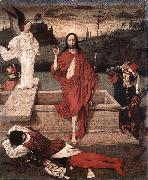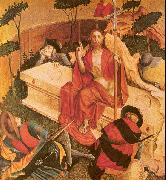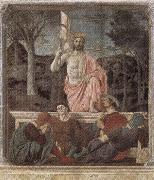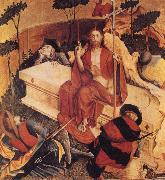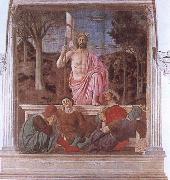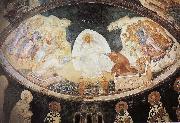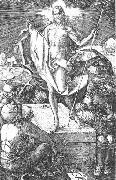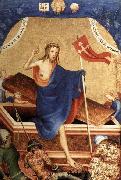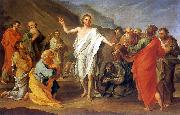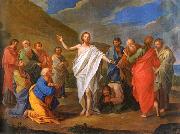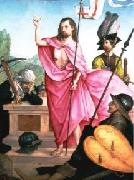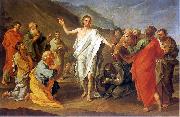Wholesale Oil Painting No Minimum |
|||||||||||
|
|
|||||||||||

|
|||||||||||
|
|
|
||||||||
Albrecht AltdorferGerman 1480-1538 Albrecht Altdorfer Galleries He most often painted religious scenes, but is mainly famous as the first frequent painter of pure landscape, and also compositions dominated by their landscape. Taking and developing the landscape style of Lucas Cranach the Elder, he shows the hilly landscape of the Danube valley with thick forests of drooping and crumbling firs and larches hung with moss, and often dramatic colouring from a rising or setting sun. His Landscape with footbridge (National Gallery, London) of 1518-20 is claimed to be the first pure landscape in oil. He also made many fine finished drawings, mostly landscapes, in pen and watercolour. His best religious scenes are intense, sometimes verging on the expressionistic, and often depict moments of intimacy between Christ and his mother, or others. His most famous religious artwork is the The Legend of St. Sebastian and the Passion of Christ that decorated the altar in the St. Florian monastery in Linz, Austria. He often distorts perspective to subtle effect. His donor figures are often painted completely out of scale with the main scene, as in paintings of the previous centuries. He also painted some portraits; overall his painted oeuvre was not large. |
||||||||
|
|
||||||||
Resurrection
Resurrection Painting ID:: 2287 |
1518
Art History Museum, Vienna 1518 Art History Museum, Vienna |
|||||||
|
|
||||||||
Dieric Bouts1420-1475 Flemish Dieric Bouts Locations Dirk Bouts whose real name was Theodorik Romboutszoon, was probably born in Haarlem, where he may have studied under the painter Albert van Ouwater. Sometime before 1450 Bouts took up residence in the Flemish city of Louvain. His name appeared in the records of Louvain in 1457 and again in 1468, when he was appointed "city painter." It is likely that Bouts spent some time in Bruges, as his earliest work, the Infancy Altarpiece shows the distinct and strong influence of Petrus Christus, the leading master of that city after the death of Jan van Eyck. The slightly later Deposition Altarpiece (ca. 1450) displays strong connections with the style of Rogier van der Weyden in both the figure types and the composition. About 1460, the period of the Entombment in London, the early, formative influence of Petrus Christus had been almost totally displaced by that of Rogier, though Bouts personal vision began to emerge in the fluid and continuous landscape background. The great Last Supper Altarpiece (1464-1467) marks the high point of Bouts career. In this solemn and dignified masterpiece the painter achieved spiritual grandeur in the context of convincing physical reality. The central panel of the altarpiece is the most emphatically significant treatment of the theme of the Last Supper in Northern European art. The wings, which contain Old Testament prefigurations of the central theme, are freer and more loosely organized. Eschewing the symmetry and rigid axial construction of the main panel, Bouts produced rhythmic foreground compositions in combination with fluid and dramatic spatial recessions. In 1468 Bouts was commissioned to paint four panels on the subject of justice for the Town Hall of Louvain. At the painter death in 1475 only two of the paintings had been completed; they are among the most remarkable productions of his career. The unusual subjects, taken from the chronicles of a 12th-century historian, concern the wrongful execution by Emperor Otto III of one of his counts and the subsequent vindication of the nobleman by his wife. The finer of the panels represents the dramatic trial by fire which the wife was obliged to undergo to prove her husband innocence. Rich draperies and sumptuous colors are applied to tall angular forms to create a work of rare formal elegance and high decorative appeal. In order to dignify the event, however, the artist has employed restrained gestures and expressions as well as a completely rationalized spatial setting. As in the Last Supper Altarpiece, a sense of solemn and hieratic importance is expressed by means of an austere and rigid geometry in the construction of both persons and places. The late productions of Bouts workshop, such as the well-known Pearl of Brabant Altarpiece, are characterized by the close collaboration of the painter two sons, Dirk the Younger (1448-1491) and Aelbrecht (1455/1460-1549). In the paintings of his less gifted sons, the master distinctive figure style was appreciably altered, though Dirk the Younger appears to have retained much of his father sensitivity to the landscape. In addition to his innovations in the depiction of landscape, Bouts made a substantial contribution to the development of the portrait. His Portrait of a Man (1462) localizes the sitter in an enlarged architectural setting while permitting the interior space to merge with the exterior through an open window. For the first time in Northern painting a common bond was forged between a particularized individual and the universal world of nature. |
||||||||
|
|
||||||||
|
|
Resurrection
Resurrection Painting ID:: 10027 |
Tempera on canvas
89 x 72,5cm Norton
Simon Museum
of Art, Pasadena Tempera on canvas 89 x 72,5cm Norton Simon Museum of Art, Pasadena |
||||||
|
|
||||||||
El GrecoGreek-born Spanish Mannerist Painter, 1541-1614 Considered a representative of late Renaissance Spanish art, El Greco was actually born in Greece, on the island of Crete. After studying in Venice under Titian, El Greco settled in Toledo, Spain in 1577. At the time he was wildly popular, his emotionally religious paintings being just the ticket for the hometown of the Spanish Inquisition. After his death his work was largely ignored until the beginning of the 20th century; now he considered one of the inspired geniuses of Western art. His distinctive style features bold shapes and colors, with elongated and slightly distorted figures. In Toledo El Greco was in constant demand and liked living large: he maintained a private orchestra to accompany his meals. |
||||||||
|
|
||||||||
|
|
Resurrection
Resurrection Painting ID:: 19024 |
approx. 1584-94, Museo del Prado, Madrid approx. 1584-94, Museo del Prado, Madrid |
||||||
|
|
||||||||
Mulready, WilliamIrish Romantic Painter, 1786-1863 |
||||||||
|
|
||||||||
|
|
Resurrection
Resurrection Painting ID:: 19584 |
1437
Tempera on wood
Gemaldegalerie, Staatliche Museen, Berlin 1437 Tempera on wood Gemaldegalerie, Staatliche Museen, Berlin |
||||||
|
|
||||||||
Piero della FrancescaItalian Early Renaissance Painter, ca.1422-1492 Italian painter and theorist. His work is the embodiment of rational, calm, monumental painting in the Italian Early Renaissance, an age in which art and science were indissolubly linked through the writings of Leon Battista Alberti. Born two generations before Leonardo da Vinci, Piero was similarly interested in the scientific application of the recently discovered rules of perspective to narrative or devotional painting, especially in fresco, of which he was an imaginative master; and although he was less universally creative than Leonardo and worked in an earlier idiom, he was equally keen to experiment with painting technique. Piero was as adept at resolving problems in Euclid, whose modern rediscovery is largely due to him, as he was at creating serene, memorable figures, whose gestures are as telling and spare as those in the frescoes of Giotto or Masaccio. His tactile, gravely convincing figures are also indebted to the sculpture of Donatello, an equally attentive observer of Classical antiquity. In his best works, such as the frescoes in the Bacci Chapel in S Francesco, Arezzo, there is an ideal balance between his serene, classical compositions and the figures that inhabit them, the whole depicted in a distinctive and economical language. In his autograph works Piero was a perfectionist, creating precise, logical and light-filled images (although analysis of their perspective schemes shows that these were always subordinated to narrative effect). However, he often delegated important passages of works (e.g. the Arezzo frescoes) to an ordinary, even incompetent, assistant. |
||||||||
|
|
||||||||
|
|
Resurrection
Resurrection Painting ID:: 30425 |
mk68
Fresco
Sansepolcro
Civice Museum
1463-1465
ltaly
mk68 Fresco Sansepolcro Civice Museum 1463-1465 ltaly |
||||||
|
|
||||||||
Hans MultscherGerman Northern Renaissance Sculptor, ca.1400-1467 German sculptor. Multscher mentions his birthplace on the inscribed band, originally a predella, of the Karg altarpiece in Ulm Cathedral (1433) and on two wings of the so-called 'Wurzach Altar' (1437) at Reichenhofen in the Allgeu. The town archives of Leutkirch, written between 1405 and 1437, record that Multscher belonged to the 'Freien Leute auf Leutkircher Heide', a commune of free peasants who had been able to preserve their independence because they were the direct descendants of Kenigsfreie, who had always been free. Under a charter of Emperor Ludwig in 1337 |
||||||||
|
|
||||||||
|
|
Resurrection
Resurrection Painting ID:: 33450 |
mk86
1437
Tempera on wood
148x140cm
mk86 1437 Tempera on wood 148x140cm |
||||||
|
|
||||||||
Piero della FrancescaItalian Early Renaissance Painter, ca.1422-1492 Italian painter and theorist. His work is the embodiment of rational, calm, monumental painting in the Italian Early Renaissance, an age in which art and science were indissolubly linked through the writings of Leon Battista Alberti. Born two generations before Leonardo da Vinci, Piero was similarly interested in the scientific application of the recently discovered rules of perspective to narrative or devotional painting, especially in fresco, of which he was an imaginative master; and although he was less universally creative than Leonardo and worked in an earlier idiom, he was equally keen to experiment with painting technique. Piero was as adept at resolving problems in Euclid, whose modern rediscovery is largely due to him, as he was at creating serene, memorable figures, whose gestures are as telling and spare as those in the frescoes of Giotto or Masaccio. His tactile, gravely convincing figures are also indebted to the sculpture of Donatello, an equally attentive observer of Classical antiquity. In his best works, such as the frescoes in the Bacci Chapel in S Francesco, Arezzo, there is an ideal balance between his serene, classical compositions and the figures that inhabit them, the whole depicted in a distinctive and economical language. In his autograph works Piero was a perfectionist, creating precise, logical and light-filled images (although analysis of their perspective schemes shows that these were always subordinated to narrative effect). However, he often delegated important passages of works (e.g. the Arezzo frescoes) to an ordinary, even incompetent, assistant. |
||||||||
|
|
||||||||
|
|
Resurrection
Resurrection Painting ID:: 40215 |
mk156
1463
Mura in fresco and tempera
225x200cm
mk156 1463 Mura in fresco and tempera 225x200cm |
||||||
|
|
||||||||
|
|
||||||||
|
|
Resurrection
Resurrection Painting ID:: 56750 |
mk250 Chola of the Christian church is now the Museum of Jesus Carrillo semicircle room frescoes. mk250 Chola of the Christian church is now the Museum of Jesus Carrillo semicircle room frescoes. |
||||||
|
|
||||||||
Bartolome Esteban MurilloSpanish 1618-1682 Bartolome Esteban Murillo Galleries Murillo began his art studies under Juan del Castillo in Seville. Murillo became familiar with Flemish painting; the great commercial importance of Seville at the time ensured that he was also subject to influences from other regions. His first works were influenced by Zurbaran, Jusepe de Ribera and Alonso Cano, and he shared their strongly realist approach. As his painting developed, his more important works evolved towards the polished style that suited the bourgeois and aristocratic tastes of the time, demonstrated especially in his Roman Catholic religious works. In 1642, at the age of 26 he moved to Madrid, where he most likely became familiar with the work of Velazquez, and would have seen the work of Venetian and Flemish masters in the royal collections; the rich colors and softly modeled forms of his subsequent work suggest these influences. He returned to Seville in 1645. In that year, he painted thirteen canvases for the monastery of St. Francisco el Grande in Seville which gave his reputation a well-deserved boost. Following the completion of a pair of pictures for the Seville Cathedral, he began to specialise in the themes that brought him his greatest successes, the Virgin and Child, and the Immaculate Conception. After another period in Madrid, from 1658 to 1660, he returned to Seville. Here he was one of the founders of the Academia de Bellas Artes (Academy of Art), sharing its direction, in 1660, with the architect, Francisco Herrera the Younger. This was his period of greatest activity, and he received numerous important commissions, among them the altarpieces for the Augustinian monastery, the paintings for Santa Mar??a la Blanca (completed in 1665), and others. |
||||||||
|
|
||||||||
|
|
Resurrection
Resurrection Painting ID:: 62658 |
mk284 Oil on canvas 243 x 164 cm Madrid, San Fernando Museum of Art mk284 Oil on canvas 243 x 164 cm Madrid, San Fernando Museum of Art |
||||||
|
|
||||||||
Albrecht Durerb.May 21, 1471, Imperial Free City of Nernberg [Germany] d.April 6, 1528, Nernberg Albrecht Durer (May 21, 1471 ?C April 6, 1528) was a German painter, printmaker and theorist from Nuremberg. His still-famous works include the Apocalypse woodcuts, Knight, Death, and the Devil (1513), Saint Jerome in his Study (1514) and Melencolia I (1514), which has been the subject of extensive analysis and interpretation. His watercolours mark him as one of the first European landscape artists, while his ambitious woodcuts revolutionized the potential of that medium. D??rer introduction of classical motifs into Northern art, through his knowledge of Italian artists and German humanists, have secured his reputation as one of the most important figures of the Northern Renaissance. This is reinforced by his theoretical treatise which involve principles of mathematics, perspective and ideal proportions. His prints established his reputation across Europe when he was still in his twenties, and he has been conventionally regarded as the greatest artist of the Renaissance in Northern Europe ever since. |
||||||||
|
|
||||||||
|
|
Resurrection
Resurrection Painting ID:: 63637 |
1512 Engraving, 119 x 75 mm Metropolitan Museum of Art, New York Sheet No. 15 of the Engraved Passion. Christ is seen holding the Flag of Peace in his left hand. In both the woodcut versions and in the Engraved Passion Christ is shown in a triumphant stance, Italianate in manner, and contrasted with the sleeping guards. In this instance Christ is standing on his sarcophagus, while in the Large Woodcut Passion he is shown suspended in the air above it.Artist:D?RER, Albrecht Title: Resurrection (No. 15) Painted in 1501-1550 , German - - graphics : religious 1512 Engraving, 119 x 75 mm Metropolitan Museum of Art, New York Sheet No. 15 of the Engraved Passion. Christ is seen holding the Flag of Peace in his left hand. In both the woodcut versions and in the Engraved Passion Christ is shown in a triumphant stance, Italianate in manner, and contrasted with the sleeping guards. In this instance Christ is standing on his sarcophagus, while in the Large Woodcut Passion he is shown suspended in the air above it.Artist:D?RER, Albrecht Title: Resurrection (No. 15) Painted in 1501-1550 , German - - graphics : religious |
||||||
|
|
||||||||
El GrecoGreek-born Spanish Mannerist Painter, 1541-1614 Considered a representative of late Renaissance Spanish art, El Greco was actually born in Greece, on the island of Crete. After studying in Venice under Titian, El Greco settled in Toledo, Spain in 1577. At the time he was wildly popular, his emotionally religious paintings being just the ticket for the hometown of the Spanish Inquisition. After his death his work was largely ignored until the beginning of the 20th century; now he considered one of the inspired geniuses of Western art. His distinctive style features bold shapes and colors, with elongated and slightly distorted figures. In Toledo El Greco was in constant demand and liked living large: he maintained a private orchestra to accompany his meals. |
||||||||
|
|
||||||||
|
|
resurrection
resurrection Painting ID:: 64067 |
painted 1584-94,cossio; 1603,mayer
108x50
the prado museum,madrid painted 1584-94,cossio; 1603,mayer 108x50 the prado museum,madrid |
||||||
|
|
||||||||
|
|
||||||||
|
|
Resurrection
Resurrection Painting ID:: 64180 |
1400 Tempera on wood, 33,1 x 21,2 cm Museum Mayer van den Bergh, Antwerp This small panel originally belonged to a polyptych which was probably conceived as a portable altarpiece or devotional painting, as it could be folded up to a size that would fit readily into a small box or leather pouch. Other panels from the polyptych representing St Christopher and the Nativity are also in the same museum. , Artist: UNKNOWN MASTER, Flemish , Resurrection , 1401-1450 , Flemish , painting , religious 1400 Tempera on wood, 33,1 x 21,2 cm Museum Mayer van den Bergh, Antwerp This small panel originally belonged to a polyptych which was probably conceived as a portable altarpiece or devotional painting, as it could be folded up to a size that would fit readily into a small box or leather pouch. Other panels from the polyptych representing St Christopher and the Nativity are also in the same museum. , Artist: UNKNOWN MASTER, Flemish , Resurrection , 1401-1450 , Flemish , painting , religious |
||||||
|
|
||||||||
Paolo Veronese1528-1588 Paolo Veronese Galleries Italian painter and draughtsman. With Titian and Tintoretto he makes up the triumvirate of great painters of the late Renaissance in Venice. He is known as a supreme colourist and for his illusionistic decorations in both fresco and oil. His large paintings of biblical feasts executed for the refectories of monasteries in Venice and Verona are especially celebrated. He also produced many altarpieces, history and mythological paintings and portraits. His compositional sketches in pen, ink and wash, figure studies in chalk, and chiaroscuro modelli and ricordi form a significant body of drawings. He headed a family workshop that remained active after his death. |
||||||||
|
|
||||||||
|
|
resurrection
resurrection Painting ID:: 69061 |
venice, s. francesco della vigna 325x160cm
se venice, s. francesco della vigna 325x160cm se |
||||||
|
|
||||||||
Juan de FlandesFlemish-born Spanish Northern Renaissance Painter, ca.1460-1519 South Netherlandish painter, active in Spain. Nothing is known of his life or work before he went to Spain, where he is first mentioned in a document of 1496 as Juan de Flandes, a painter in the service of Queen Isabella of Castile. Treasury accounts confirm that he held this position until the Queen death in 1504. On arriving in Spain, he must have lived in Burgos, where he certainly met MICHEL SITTOW, another painter in the Queen service, who had been at the Castilian court since 1492. |
||||||||
|
|
||||||||
|
|
Resurrection
Resurrection Painting ID:: 87439 |
Date c. 1508(1508)
Medium Tempera and oil on panel.
Dimensions 131 x 87.5 cm (51.6 x 34.4 in)
cjr Date c. 1508(1508) Medium Tempera and oil on panel. Dimensions 131 x 87.5 cm (51.6 x 34.4 in) cjr |
||||||
|
|
||||||||
Szymon Czechowicz(1689-1775) was a Polish painter. |
||||||||
|
|
||||||||
|
|
Resurrection
Resurrection Painting ID:: 87798 |
1758(1758)
Medium Oil on canvas
cyf 1758(1758) Medium Oil on canvas cyf |
||||||
|
|
||||||||
Szymon Czechowicz(1689-1775) was a Polish painter. |
||||||||
|
|
||||||||
|
|
Resurrection
Resurrection Painting ID:: 90327 |
1758(1758)
Medium oil on canvas
cyf 1758(1758) Medium oil on canvas cyf |
||||||
|
|
||||||||
Juan de FlandesFlemish-born Spanish Northern Renaissance Painter, ca.1460-1519 South Netherlandish painter, active in Spain. Nothing is known of his life or work before he went to Spain, where he is first mentioned in a document of 1496 as Juan de Flandes, a painter in the service of Queen Isabella of Castile. Treasury accounts confirm that he held this position until the Queen death in 1504. On arriving in Spain, he must have lived in Burgos, where he certainly met MICHEL SITTOW, another painter in the Queen service, who had been at the Castilian court since 1492. |
||||||||
|
|
||||||||
|
|
Resurrection
Resurrection Painting ID:: 92214 |
1508(1508)
Medium Tempera and oil on panel.
Dimensions 131 X 87.5 cm (51.6 X 34.4 in)
cyf 1508(1508) Medium Tempera and oil on panel. Dimensions 131 X 87.5 cm (51.6 X 34.4 in) cyf |
||||||
|
|
||||||||
Szymon Czechowicz(1689-1775) was a Polish painter. |
||||||||
|
|
||||||||
|
|
Resurrection
Resurrection Painting ID:: 97338 |
1758(1758)
Medium oil on canvas
cyf 1758(1758) Medium oil on canvas cyf |
||||||
|
|
||||||||
|
Szymon Czechowicz (1689-1775) was a Polish painter. Resurrection 1758(1758) Medium oil on canvas cyf |
||||||||
|
|
||||||||
|
Prev Next
|
||||||||
|
|
||||||||
|
Related Paintings to Szymon Czechowicz :. |
||||||||
|
|
||||||||
|
CONTACT US |


